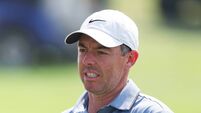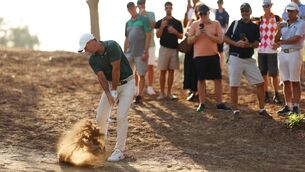How many more golf courses can Ireland take?
Because they cost so much money to build and develop, these luxurious venues are going to have to charge very steep green fees if the original investment is ever to be recouped.
Over the past 15 years or so quite a large number have been successful in this respect, but several others have, at best, struggled to make ends meet.
Classic examples of the former are Mount Juliet in County Kilkenny and The K-Club in County Kildare.
Mount Juliet, of course, was Jack Nicklaus's first design job in this country and to say that he and his team did a good job is an understatement.
From day one, it was a huge success and next September will house the American Express World Championship for the second time in three years.
The K-Club got off to a less enviable start. Arnold Palmer and his team designed a fabulous golf course, if one that initially struggled with the vagaries of the Irish weather. But they eventually got it right; it will stage the Ryder Cup in 2006 having put on the European Open since 1995.
Inspired and enthused by their success, Tim Mahony of Mount Juliet, and Michael Smurfit of The K-Club, invested further in Irish Golf.
Mahony bought Fota Island in Cork harbour and Smurfit added a second course at Straffan. Once more, they proved to have the Midas Touch nor were they afraid to spend massive sums of money to guarantee success.
Mount Juliet and The K-Club were but the tip of the iceberg. New courses and complexes sprang up everywhere.
Hugo Flinn was quickly in with Druids Glen in County Wicklow. Pat Ruddy did a fine job on the design of the course and within a short few years the course was hosting the Irish Open for four successive years.
Not far away, the Slazenger family developed 36 holes of prime land at Powerscourt. More recently, the Mallahan family have converted some prime land at their Carton House in County Kildare into golf courses designed by Mark O'Meara and Colin Montgomerie. Tom Keane has launched the work of Severiano Ballesteros and Jeff Howes at the Heritage near Portlaoise.
Every nook and cranny in the country has a commercial golf course these days. Naturally enough, considering population density, most are in within easy reach of Dublin. Luttrellstown Castle, Tulfarris and St Margaret's, spring readily to mind, but there are others, probably too many to mention.
Most of the aforementioned have paid their way or are about to do so. Others haven't been quite so fortunate. Thankfully, none have gone to the wall. Instead, second or even third time buyers stepped in to snap up a bargain and keep the ship afloat.
This is great news for the development of the game throughout Ireland and there are so many of which we can be justifiably proud:
Glasson on Lough Ree, near Athlone;
Sean Quinn's Slieve Russell in County Cavan;
Galway Bay at Oranmore; Adare Manor and Limerick County in County Limerick; Old Head, Fota Island, Harbour Point and Lee Valley in County Cork; Mount Wolseley and Killerig Castle in County Carlow, Faithlegg and Waterford Castle in County Waterford, St Helen's Bay in County Wexford, Hilton Templepatrick in County Down, Rathsallagh, County Wicklow; Ring of Kerry near Kenmare, County Kerry; Roe Park, County Derry; Seapoint, County Louth; Woodstock, County Clare and Ballykisteen, County Tipperary.
Some of these have since been bought out by the members, in almost every case to the satisfaction of all concerned and that, of course, is further good news for Irish golfers.
However, the list I have just presented (and there are quite a few others as well) is its own indication that the market must now be close to, if not past, saturation point. To make many of these courses pay their way, green fee rates have to be pegged at an extremely high level.
In 2003, it cost, respectively, €265 and €250 to play The K-Club and Old Head. Other fees included: Mount Juliet and Druids Glen €140; Carton House €110; Powerscourt €100; Luttrellstown €85; Fota Island €83; Galway Bay €55; Glasson €50; Hilton Templepatrick stg£40; Limerick County €37.
Extremely expensive in some cases, not so bad in others. The fact is, though, that Irish golf is now officially very dear.
The Minister, John O'Donoghue, has said so. So has Damien Ryan, chief of Fáilte Ireland's very active and energetic golf marketing programme.
The owners of these complexes and indeed the private clubs, many of whom are charging well over 100 for a round argue that they must peg their prices this high if they are to make ends meet.
Can the market measure up to their expectations? Many believe the answer is no. Yet these developments keep popping in every part of the country with Killeen Castle the latest example. Let's hope things keep fine for all concerned.















